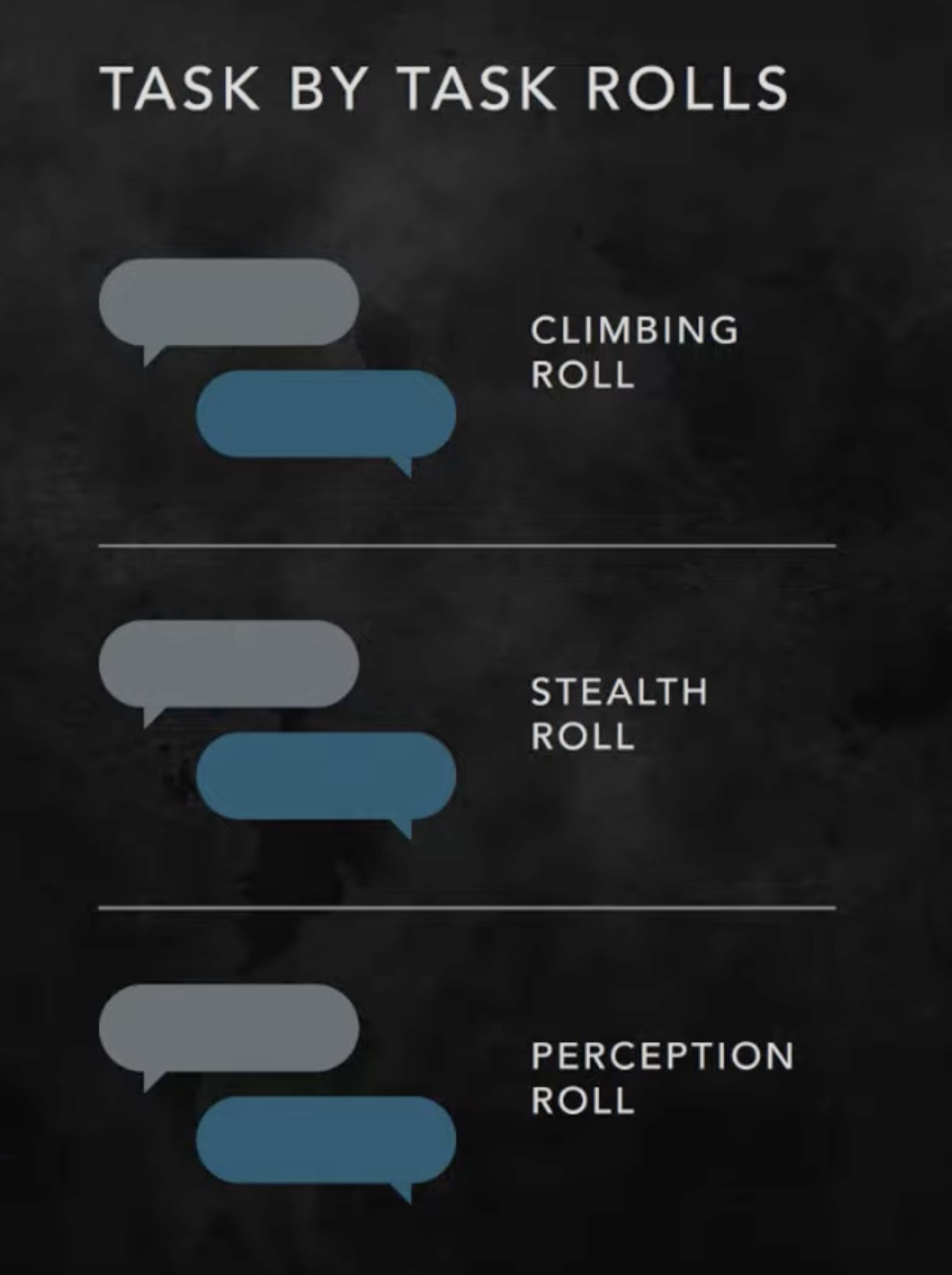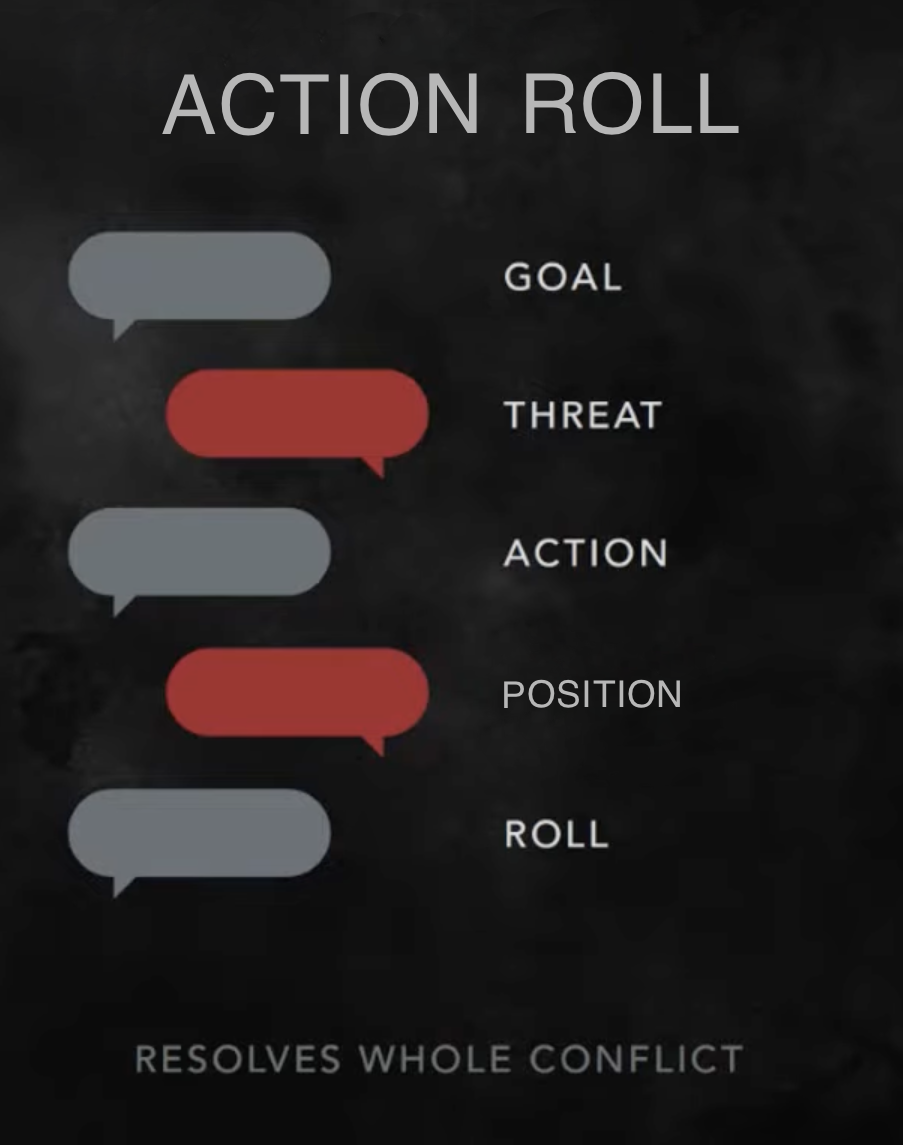03 - Action Tests

Jump to:
Position and Outcome
Types of Consequences
Levels of Difficulty
Adding Dice and Altering the Outcome
See Actions.
Actions will let you handle difficult situations. There are thirteen of them, each linked to a certain Attribute.
When using an Action, you start by adding the Action value and the Attribute together. The sum determines how many six-sided dice you get to roll.
Rolling a six counts as a success.
You sometimes need more than one success in order to pass an Action test.
Also note that your player character is free to use any Action in the game, even if their Action value is 0; in that case you simply roll the number of dice indicated by the relevant Attribute. The same applies if you attempt something that is not covered by a specific Action.
Fiction First
The important concept here is that you first choose what your character does in the fiction, then the group picks a mechanic that suits the situation to resolve what happens. Once you establish the fictional action, selecting a mechanic from the options at hand is pretty easy. If you try to do it the other way around—picking the mechanic and then trying to “color-in” the fiction after—you’ll find that the game can become confusing and muddled.
When something seems weird, or a situation resolves in a bizarre way, back out to the level of the fictional narrative. What’s going on? What are you trying to do? Which mechanic is suited for this? Don’t try to force a particular mechanic onto the fiction. Take the fiction first (ah, see that? “fiction-first”) and then use the mechanics to support it.
Triggering the Action Test
Jump to:
Position and Outcome
Types of Consequences
Levels of Difficulty
Adding Dice and Altering the Outcome
The game is a conversation between the people at the table. You’re talking, narrating actions, speaking in character, making jokes, sketching maps, speculating about what might happen, all that good stuff. But it’s just talking, right? There’s a thing that happens in a roleplaying game where the conversation shifts. Where you go from just talking to using a mechanic. What’s that like?
This shift in the conversation is the Director’s responsibility (they should always be on the lookout), but anyone can call for it. So, when do you call for it? You call for an action roll when any of these happen:
- A player character attempts a challenging action that might be dangerous or troublesome.
- A player character leads or gives orders to an NPC or NPC group, which faces something dangerous or troublesome.
- Someone grabs the dice and gets excited about making a roll.
So, then, what do you actually say? First ask the player how they’re accomplishing their action: Which of their actions will they use?
Then, suggest the position the character is in.
The Rhythm of Play
The typical RPG goes one task at a time, one roll per task. It goes back and forth and it's fairly simple.
Player: "I want to get up on this rooftop."
Director: "Okay, give me a climbing check."

In our game, the rhythm will go a bit differently.
First, the Player will state their Goal. This will tell us why the PC is doing what they are doing.
Then the Director will present a Threat. This is what the PC will confront or deal with.
The Player then describes which Action they will use to deal with the Threat.
Based on the Action, the Director sets the Position. This might be negotiated by the Director and the Player.
Finally, the Player Rolls to determine the outcome, which is primarily narrated by the Director (but can be added to by the Players).

This mimics the Blades in the Dark style Action resolution. For further understanding of this concept, you can check out this video.
Position and Outcome
The Director sets position for an Action test after the player says what they’re doing and chooses their Action. Usually, Risky is the default, modified by the Action being used and the strength of the opposition.
| Controlled | Risky | Desperate | |
|---|---|---|---|
| Multiple Successes | Success with a bonus See the used Action |
Success with a bonus See the used Action |
Success |
| Success | Success with a bonus +1 to your next roll |
Success | Success with a consequence |
| Failure | Success with a consequence A minor complication, suffer minor harm |
Things go badly A complication, Suffer moderate harm, lose the opportunity |
The worst outcome A serious complication, suffer severe harm, lose the opportunity |
Types of Consequences
Complications
Lost Opportunity
Worse Position
Harm
Complications
This consequence represents trouble, mounting danger, or a new threat. The Director might introduce an immediate problem that results from the Action right now: the room catches fire, you’re disarmed, evidence or witnesses see things the wrong way, you lose status nobleperson, the target evades you and now it’s a chase, reinforcements arrive, etc.
A serious complication is more severe: reinforcements surround and trap you, the room catches fire and falling ceiling beams block the door, your weapon is broken, your target escapes out of sight, etc.
Lost Opportunity
This consequence represents shifting circumstance. You had an opportunity to achieve your goal with this Action, but it slips away. To try again, you need a new approach—usually a new form of action or a change in circumstances. Maybe you tried to Force the noble to trap her on the balcony, but she evades your maneuver and leaps out of reach. If you want to trap her now you’ll have to try another way—maybe by Charming her with your roguish allure.
Worse Position
This consequence represents losing control of the situation—the action carries you into a more dangerous position. Perhaps you make the leap across to the next rooftop, only to end up dangling by your fingertips. You haven’t failed, but you haven’t succeeded yet, either. You can try again, re-rolling at the new, worse position. This is a good consequence to choose to show escalating action. A situation might go from controlled, to risky, to desperate as the action plays out and the PC gets deeper and deeper in trouble.
Harm
See Harm.
Levels of Difficulty
In extreme cases, the Director may decide that it takes more than one success to succeed. This might happen when attempting to persuade a lynch mob to release the accused, or when you are being pursued by a killer across the stormy rooftops of a town. A challenging action requires two successes, while a difficult one requires three successes.
| Action | Number of Successes |
|---|---|
| Normal | 1 |
| Challenging | 2 |
| Difficult | 3 |
Multiple Successes
Rolling more successes than required means that you are extra successful. You impress yourself as well as others, get more than you wanted, or win renown for your skillfulness. In some cases, the Director may deem your surge in confidence so great that you heal a Harm.
Some Actions let you use extra successes to achieve certain effects, such as helping another player character who has failed the same kind of Action test. Each effect costs one success. The Director has final say on whether or not (and for what purpose) you may use your extra successes.
If the Level of Difficulty is higher than 1, you only get extra successes for each one your roll over the number of successes required for that Action.
For example, if it's a Challenging test (so 2 Successes are required), and you roll 2 successes on your Action test, you don't get any extra successes from that roll.
Jump to Actions.
Failed Tests
Failing a test means that something detrimental or unexpected happens to you. In most situations the implications are quite obvious. A failed attempt at sneaking means that you are detected. If you are trying to inspire a crowd they may turn against you. Even before the roll is made, the Director should try to be clear about what happens if the test fails.
In particularly difficult or dangerous situations, failing a test also means that you become afflicted with Harm. The Director should inform you of this before you roll.
Not all tests carry the risk of acquiring Harm.
See also Position and Outcome.
Opposed Rolls
There will be many situations where an NPC or a player character tries to stop you from succeeding. A guard may try to detect you while you are sneaking. You and your friend disagree on something and each try to sway the opinion of the other. In such cases the outcome is decided by opposed rolls.
You and your opponent each make a roll. The person with the most successes prevails. Should both get an equal number of successes, you have neither succeeded nor failed. If your opponent is an NPC the Director may use a Consequence.
You get what you want, but something goes wrong.
Adding Dice and Altering the Outcome
A basic rule is that everything affecting the roll is added together. If you have a Talent that adds +2 to the roll, and you Push to gain another +2, you get four extra dice to roll. Should you also be injured and have Harm, that deducts one die, giving you a total of three extra dice.
Flashbacks
Pushing the Roll
Risk Peril
Helping Each Other
Equipment
Flashbacks
When you are attempting an Action, you can invoke a flashback to roll for an action in the past that impacts your current situation.
Maybe you convinced the district Watch sergeant to cancel the guard patrol tonight, so you make a Persuade roll to see how that went.
Your character gets 1 flashback per day.
The Director sets a Level of Difficulty when you activate a flashback.
Level of Difficulty 0 or 1: An ordinary action for which you had easy opportunity. You Persuaded your friend Chaela to agree to arrive at the dice game ahead of time and to suddenly spring out as a surprise ally.
Level of Difficulty 2: A complex action or unlikely opportunity. You Finessed you daggers into a hiding spot near the card table so you could retrieve them after the pat-down at the front door.
Level of Difficulty 3 (or more): An elaborate action that involved special opportunities or contingencies. You already Studied the history of the property and learned of a ghost that is known to haunt its ancient canal dock— a ghost that can be compelled to reveal the location of the hidden vault.
After the Action test is made, a flashback is handled just like any other action.
Sometimes it will entail an action roll, because there’s some danger or trouble involved. Sometimes a flashback won’t call for a roll at all because of the Level of Difficulty.
One of the best uses for a flashback is when your Action test goes badly. After the Director describes the trouble you’re in, you can call for a flashback to a special preparation you made, “just in case” something like this happened. This way, your “flashback planning” will be focused on the problems that do happen, not the problems that might happen.
If the flashback goes well, it may add addition dice to your next Action roll if it's relevant.
Limits of Flashbacks
A flashback isn’t time travel. It can’t “undo” something that just occurred in the present moment. For instance, if Inspector Helker confronts you about recent thefts of occult artifacts when you’re at Lady Bowmore’s party, you can’t call for a flashback to assassinate the Inspector the night before. She’s here now, questioning you—that’s established in the fiction. You can call for a flashback to show that you intentionally tipped off the inspector so she would confront you at the party—so you could use that opportunity to impress Lady Bowmore with your aplomb and daring.
Pushing the Roll
Having failed a test, you can choose to muster your strength and give it one more try. This can only be done once per action, and must happen immediately after failing a test. This is called a Push, or Pushing the roll.
When you Push, you suffer a Level 1 Harm.
You can choose the type of Harm, but you should choose the one that is most appropriate to the Action and the situation.
If you are using Strength or Dexterity you will probably suffer a Physical Harm, and if you are using Intuition, Reason, or Presence you will probably suffer a Mental one.
You may then re-roll the dice except the sixes, and gain a +2 on the re-roll.
You can push rolls that have already succeeded, since there are situations where multiple successes make you succeed particularly well.
If you have no space to take a Level 1 Harm, you cannot Push the roll.
Risk Peril
As long as the roll is not being Pushed, the Director or any other player can offer you a +3 bonus dice if you accept Risking Peril.
Some examples include:
- Collateral damage, unintended harm.
- Sacrifice an item.
- Betray a friend or loved one.
- Offend or anger someone.
- Suffer Harm (Moderate or greater)
Risk Peril cost occurs regardless of the outcome of the roll. You make the deal, pay the price, and get the bonus die. There might not be an interesting way to Risk Peril in every situation. If one doesn’t occur to anyone right away, that’s fine.
Some players like to get a little fancy or creative with Risking Peril, using them to re-write a bit of the situation, create something new in the flow of the narrative, or shine a spotlight on a character’s weaknesses.
Don’t push these bargains too hard if the player doesn’t like this kind of narrative sleight-of-hand. It’s fun for some and annoying for others.
Risk Peril is always a free choice. If you don’t like one, just reject it (or suggest how to alter it so you might consider taking it).
If it’s ever needed, the Director has final say over which Risk Perils are valid.
Helping Each Other
Other player characters can increase your chance of passing an Action test by offering to help with whatever you are attempting to do. The Director decides whether you really do benefit from their help.
You gain +1 to your Action test for every person helping you, to a maximum of +3.
Equipment
Most of the items you find are of the everyday variety, but some can be more useful, increasing your chance of passing your Action tests.
Additionally, specific equipment may be required to perform an Action. You might need lockpicks to open something, or medical supplies to treat a wound.
These items add a bonus to your test, usually +1. Some special or even magic items may grant you a greater bonus, but rarely more than +3.
Jump to Actions.